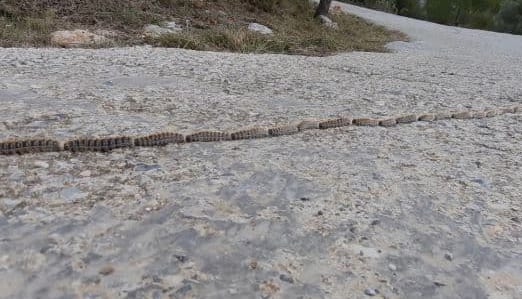BEWARE OF PINE AND OAK TREES
The warmer parts of Europe have been suffering from these for years in pine trees but now, sadly they are starting to appear in the UK, though mostly on oak trees.
Processionary caterpillars are painfully irritating for humans but can be deadly for pets…

WARNING to all pet owners
Just one sniff, or worse, eating a processionary caterpillar can be fatal for animals. Their hairs (which they release whenever they feel threatened as a defence mechanism) are incredibly toxic.
Even if your dog or cat has inadvertently walked in the hairs and licks their paws hours later, it’s still as toxic.
Small children and pets are particularly vulnerable to the toxic caterpillars. And their hairs can be blown everywhere in strong wind and cause issues even if you don’t come into direct contact with the creature itself.

In Spain and Portugal, they are usually at their worst in February and March but can appear as early as December through to the end of May when they drop out from their pine tree nests.
In the UK the worst months are May to July but it’s more likely to be from oak trees and they are much harder to see than the pine tree ones – see the video below.
Garden owners please carefully consider…

Whilst the oak moth is currently only in the south-east of England it’s highly likely it will spread all over the UK if the pine moth in Europe is anything to go by. So really carefully consider your tree planting choices.
As much as it pains me to say it, I will no longer be planting oak or pine trees.
What to do if your pet comes in contact with the toxic caterpillar hairs*
*Please note, I’m not a qualified vet, nor do I play one on the internet, so please do your own research. That being said, here are some tips I’ve come across so far…
- Get your pet to the vet IMMEDIATELY. The quicker you can get them there the better.
In Spain, there are emergency 24hr vets specifically for caterpillar toxin treatments. I don’t know if the same applies in the UK as this is a fairly new problem.
The Blue Cross has more info on what symptoms to look out for.
I’ve read that heat helps destroy the toxin. One website recommended pouring hot (but not scalding) water with salt onto the affected area.
Another site recommended getting the homoeopathic remedy Apis (which is said to help prevent anaphylactic shock) and administer it immediately.
BUT please note the above possibilities are NOT cures, they might help a bit until you can get to a vet.
I already carry activated charcoal in my hiking kit which I think might also help but I will be adding Apis and a flask of hot salty water to our backpack.
My dog is the most curious creature on earth and fascinated by anything that moves so I know she’d investigate them. She’ll have to be kept on a lead during the worst months when we’re in Spain, Portugal or Italy.
As much as she’ll hate it, I’m considering a muzzle for the month before and after the main season so at least she can’t get them in her mouth (in severe cases some dogs have to have their tongue amputated after contact with the toxin).
Report them to reduce the spread
If you’re in the UK and see any processionary caterpillars, you must report them to the Forestry Commission on their Tree Alert Portal. They will come and get rid of them (do not try to do it yourself!).

I’ve always found the processionary caterpillars fascinating, but that was when I didn’t have a dog! I now understand why every dog owner has a look of horror whenever they are seen or mentioned.
So I urge you to read more about what you can do to help prevent their spread and keep vigilant whenever you’re out for a walk.
*Photo credits: Pine tree nest – Paula Rogers, Caterpillar close-ups – Dita.
4 replies to "Creeping Killer Critters – be careful what you plant in your garden"
Oh no, I’ve always loved caterpillars, so will certainly be keeping vigilant with these! Thanks for sharing this.
Thank you for sharing this information.
Hopefully many people will share this on their social platforms so more people are aware and can help prevent unwanted situations with their children and pets.
Thanks, Wanda. Yes, this information needs to be shared as much as possible.
Hi Rachel I am sure everyone is grateful for that scary warning.
All over the World countries are finding invasive pests and plants
Major climate change every day, one can read something awful.
Tomorrow I will phone the Botanic Gardens and talk about those
nasty creatures
But I suppose they are just doing their caterpillar thing. So be it .
I am reading David Attenoroughs book A Life On Or Planet .A
wonderful publication ,not much hope.
Anyway happy gardening and good luck with the hiking its baltic here .Take Care Brendan